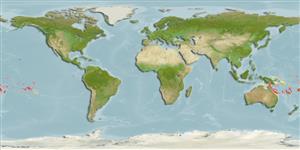>
Blenniiformes (Blennies) >
Tripterygiidae (Triplefin blennies) > Tripterygiinae
Etymology: Enneapterygius: Greek, ennea = nine times + Greek, pterygion = little fin (Ref. 45335).
More on author: Fricke.
Environment: milieu / climate zone / depth range / distribution range
Ecologie
marien rifbewoner; diepte 0 - 17 m (Ref. 13227). Tropical
Southwest Pacific: Australia, Vanuatu, Fiji, then east to American Samoa, and the French Polynesia.
Grootte / Gewicht / Leeftijd
Maturity: Lm ? range ? - ? cm
Max length : 4.5 cm SL mannelijk / geslacht onbekend; (Ref. 54980)
Korte beschrijving
Determinatiesleutels | Morfologie | Morfometrie
Dorsale stekels (totaal) : 14 - 17; Dorsale zachte stralen (totaal) : 7 - 11; Anale stekels: 1; Anale zachte stralen: 17 - 21. Small and slender supraorbital tentacle; in males, first spine of first dorsal fin higher than first spine of second dorsal fin; in females, first dorsal fin a little less than 50% shorter than second dorsal fin; females whitish, with fine black dots, bearing a reticular red or brown pattern, isolating the white into 2-3 longitudinal rows of blotches; male coloration similar but generally darker. Dorsal rays III + XI-XIII + 7-10; lateral line interrupted, 14-20 + 14-21; mandibular pores 3-4 + 1 + 3-4 (Ref. 54980).
Female members of the Tripterygiidae have eggs that are hemispherical and covered with numerous sticky threads that anchor them in the algae on the nesting sites (Ref. 240). Larvae are planktonic which occur primarily in shallow, nearshore waters (Ref. 94114).
Levenscyclus en paargedrag
Maturities | Voortplanting | Spawnings | Egg(s) | Fecundities | Larven
Fricke, R., 1994. Tripterygiid fishes of Australia, New Zealand and the southwest Pacific Ocean (Teleostei). Theses Zool. 24:1-585. (Ref. 13227)
Status op de Rode Lijst van het IUCN (Ref. 130435)
Gevaar voor de mens
Harmless
Gebruik door de mens
Visserij: van geen belang
Tools
Speciale rapporten
Download XML
Internetbronnen
Estimates based on models
Preferred temperature (Ref.
123201): 25 - 29, mean 27.1 °C (based on 457 cells).
Fylogenetische diversiteitsindex (Ref.
82804): PD
50 = 0.5000 [Uniqueness, from 0.5 = low to 2.0 = high].
Bayesian length-weight: a=0.00562 (0.00258 - 0.01228), b=3.08 (2.89 - 3.27), in cm total length, based on LWR estimates for this (Sub)family-body shape (Ref.
93245).
Trofisch niveau (Ref.
69278): 3.2 ±0.3 se; based on size and trophs of closest relatives
Weerstandsvermogen (Ref.
120179): Hoog, minimale populatieverdubbelingstijd minder dan 15 maanden (Preliminary K or Fecundity.).
Fishing Vulnerability (Ref.
59153): Low vulnerability (10 of 100).
Nutrients (Ref.
124155): Calcium = 371 [165, 1,059] mg/100g; Iron = 1.83 [0.77, 3.67] mg/100g; Protein = 18.3 [16.8, 19.8] %; Omega3 = 0.102 [0.036, 0.307] g/100g; Selenium = 47 [13, 150] μg/100g; VitaminA = 56 [11, 275] μg/100g; Zinc = 4.02 [2.07, 6.83] mg/100g (wet weight);
